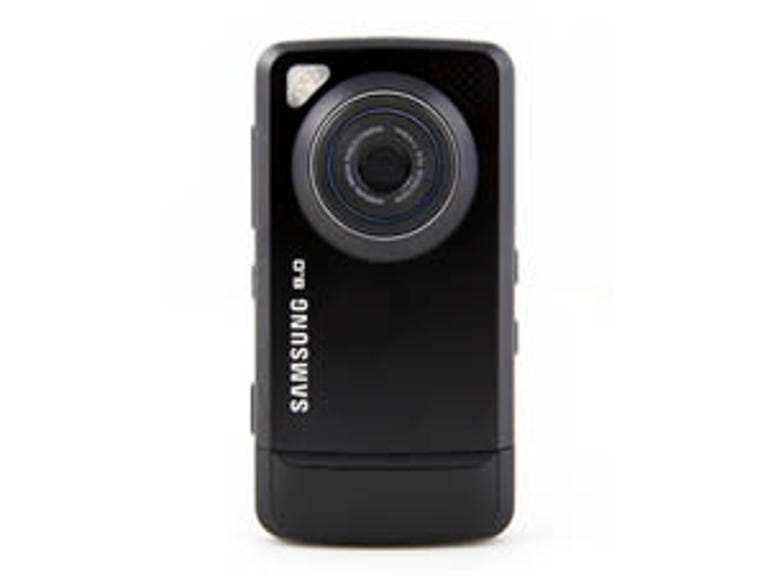 Why You Can Trust CNET
Why You Can Trust CNET Samsung Pixon review: Samsung Pixon
Samsung's love affair with touchscreen phones has produced some gems -- and some stinkers. The latest direction both Samsung and its Korean arch-rival LG are taking touchscreens is the high-end camera phone. The Pixon packs 8 megapixels and a dual LED flash, but can it outshine its rivals?
Samsung's love affair with touchscreen phones has produced some gems -- and some stinkers. The latest direction both LG and Samsung are taking touchscreens is the high-end camera phone. The Samsung Pixon aims to delight you with an 8-megapixel camera, but is it an annoying pap or a bona fide Rankin?
The Good
The Bad
The Bottom Line
The Samsung Pixon is currently available for free on a monthly contract.
Design
Compared to the LG Renoir, the Pixon takes itself a little more seriously. A solid-feeling black casing houses a large touchscreen and on the back an 8-megapixel camera that juts out in a similar fashion to the one on the LG Renoir. Unlike the Renoir though, the Pixon's lens cover opens and shuts automatically.

The Samsung's touchscreen is as responsive as the Renoir's screen, but not as responsive as the iPhone's or T-Mobile G1's. You may find that at times the screen doesn't respond as expected, but with a little practice it is usable. Unlike the iPhone, there are mechanical keys for taking pictures, which is a relief.
The Pixon's software is Samsung's own mix of cute icons and widgets. You can drag several apps on to the homepage for easy access and flick photos left and right as you would on an iPhone -- there are no multi-touch gesture controls, however. It looks good, but it's no Google Android, which we hope to see on Samsung phones soon.
Features
Just like you'd use a standalone camera, to take a picture you hold the Pixon sideways and press the dedicated shutter button. A simple to use on-screen interface offers up a series of camera options, including shooting mode, flash, exposure value and auto-focus, among others.
Pictures in daylight and well-lit areas came out really well -- colours were balanced and the pictures looked sharp. In low light we were less impressed by the picture quality, because the dual LED photo lights didn't provide enough illumination. It would have been great to see a xenon flash on the Pixon instead.
Similar to the LG Renoir, the Pixon's texting interface offers a traditional on-screen keypad layout or a full Qwerty keypad, depending on which way you hold it. While it can be fiddly at times, it does work and after some practice you'll be able to tap out messages fairly easily.
Viewing photos is a noteworthy experience, as the Pixon gives you the option to view one photo at a time or zoom out and view them as if they were sprawled out on a table. You can use your finger to flick each photo to the side and view the next one -- it's actually very useful when you're trying to view several photos in one go.
You can geo-tag pictures, marking the location they were taken using the Pixon's GPS. We expected to be able to use the GPS alongside Google Maps, but oddly the option doesn't appear. Shooting video was a more satisfying experience -- the Pixon allows you to shoot at up to 120 frames per second, which creates a smooth-looking video.
An unusual feature is the ability to play DivX and Xvid videos, which is great if you want to store large video files on the Pixon and watch them on the go. You'll need to convert the files first, which you can do using the provided software in the box. We tested a few film trailers out and they looked excellent on the big screen.
Other features include a music player that's easy to understand and use. You can add a widget to the homepage to access the music keys easily, which is useful. Our only disappointment with the music player is you have to you use the provided adaptor to plug in standard 3.5mm headphones, which is annoying.
Performance
Battery life lasted over a day with moderate
use before we needed to recharge the Pixon. It obviously lasted much
less when we used the camera or the HSDPA -- you can save energy by
turning this off, but this will affect download speeds of course. It
also helps to turn the screen's brightness down.
Conclusion
The Samsung Pixon is an accomplished camera
phone that takes high-quality pictures in low light. Compared to the
Renoir we found the interface to be a little more refined, but overall
it's a very similar experience. As we pointed out with the Renoir, the
Pixon's touchscreen isn't the best out there and we think both
companies can do better.
We'd also like to see Samsung and LG produce an Android handset soon and hopefully combine it with an extremely responsive screen. As we saw with the Samsung i8510, which runs Symbian, a move towards a more open platform makes for a much better user experience and will ultimately help push these South Korean companies forward.
Edited by Nick Hide
